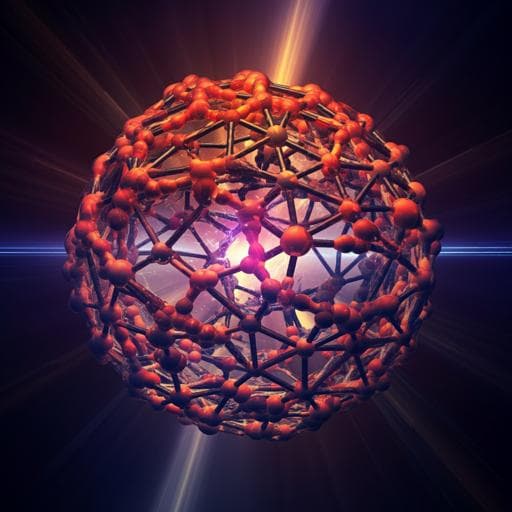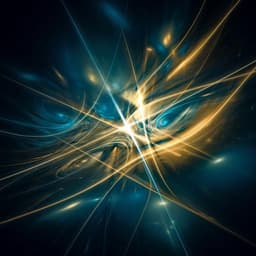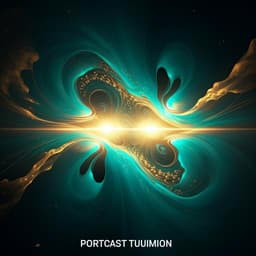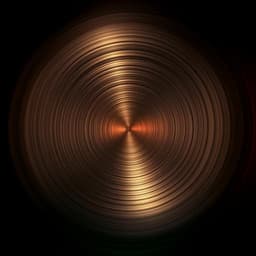
Physics
Giant anomalous Hall and Nernst effect in magnetic cubic Heusler compounds
J. Noky, Y. Zhang, et al.
This paper reveals groundbreaking insights into the intrinsic anomalous transport properties of magnetic cubic full Heusler compounds, highlighting significant advancements in the anomalous Hall effect and anomalous Nernst effect. Conducted by Jonathan Noky, Yang Zhang, Johannes Gooth, Claudia Felser, and Yan Sun, the study showcases the pivotal role of symmetries and magnetism in these materials, promising exciting applications in other linear responses.
~3 min • Beginner • English
Introduction
The study addresses how magnetism and band topology in cubic full Heusler compounds can generate large intrinsic linear response effects—specifically the anomalous Hall effect (AHE) and anomalous Nernst effect (ANE)—through enhanced Berry curvature (BC). Prior topological materials databases mainly treat non-magnetic systems, leaving magnetic materials and their symmetry-broken responses less systematically explored. Heusler compounds are versatile, often magnetic, and host topological band features, making them prime candidates to exhibit large intrinsic AHE/ANE and related responses. The research aims to establish guiding principles linking crystal symmetry (e.g., mirror planes), magnetization, electronic filling (valence electron count), and band-structure features (nodal lines and Weyl points) to the magnitude of AHE/ANE, to identify high-performance compounds and provide design rules for maximizing these effects.
Literature Review
Recent advances in topological quantum chemistry enable systematic classification of non-magnetic topological materials, but magnetic systems require compound-by-compound studies. Prior works identified Weyl fermions and nodal-line fermions in magnetic systems and demonstrated large anomalous transport in selected Heusler compounds. Notably, Co2MnGa exhibits the highest reported ANE (~6 A m−1 K−1) achieved via doping, and Heusler materials have shown strong AHE and magneto-optical Kerr effect (MOKE). However, the vast compositional space necessitates simple design rules. This study builds on theoretical models that link mirror-symmetry-protected nodal lines, their gapping by spin–orbit coupling (SOC) under magnetization, and the resultant BC hot spots to intrinsic AHE/ANE, extending these ideas across the full set of stable cubic magnetic full Heuslers.
Methodology
- Dataset: All stable, cubic, magnetic full Heusler compounds from the University of Alabama Heusler Database were selected (255 materials). Non-magnetic compounds were excluded because intrinsic AHE/ANE require broken time-reversal symmetry.
- DFT calculations: VASP with PAW pseudopotentials and GGA (PBE) exchange-correlation. k-point mesh 13×13×13. Magnetization initialized with varied starting moments to reproduce total magnetization from the database; final magnetization direction set along (001). Due to cubic symmetry, the integral anomalous transport coefficients are insensitive to the magnetization direction despite local BC redistribution.
- Wannierization: Maximally localized Wannier functions (Wannier90) constructed by projecting Bloch states onto atomic orbitals. Disentanglement with tuned inner/outer energy windows; iterations continued until the average energy difference between DFT and MLWF bands along high-symmetry paths in the energy window EF−4 eV to EF+4 eV was <1 meV.
- Tight-binding and response calculations: A tight-binding Hamiltonian was extracted from MLWFs. Berry curvature was computed via the Kubo formalism. Intrinsic anomalous Hall conductivity (AHC) and anomalous Nernst conductivity (ANC) were evaluated from BC following established formulas. Optical Hall conductivity σ(ω) was calculated via Kubo formalism, and Kerr angles were derived from σ(ω).
- Model analysis: A four-band model (parameters m=M=c=1 eV, B=2 eV) with mirror symmetry supporting a nodal line was used to elucidate how SOC plus magnetization along x breaks the mirror symmetry (λ=0.01) to gap the nodal line, producing BC concentrated along the former nodal line and enhancing AHE/ANE.
- Statistical correlations: Responses (AHC, ANC, Kerr angle) were correlated with space group (SG 225 vs 216), lattice parameter, magnetic moment, valence electron count, and density of states at EF. Energy dependence around EF was analyzed by scanning ±250 meV to emulate doping/tuning effects.
Key Findings
- Symmetry control:
- Regular full Heuslers (SG 225) possess three orthogonal mirror planes enabling symmetry-protected nodal lines. Under magnetization (e.g., along (001)) and SOC, two mirrors are broken, gapping the nodal lines and generating large BC. SG 225 compounds statistically show larger AHC, ANC, and Kerr angles than inverse Heuslers (SG 216).
- Electron count trends:
- AHC and ANC versus valence electrons exhibit a double-peak structure with maxima near 21 and 28 electrons and a minimum near 23–24 electrons. Scanning EF within ±250 meV preserves this trend in the maxima of AHC/ANC.
- Relationship between AHC and ANC:
- At EF, ANC and AHC show no clear correlation. However, the maxima of |ANC| within ±250 meV correlate linearly with the corresponding maxima of |AHC|, reflecting a common dependence on large BC hot spots at some accessible energy.
- Materials highlights (selected from Table 1):
- Very large AHC at EF: Co2MnAl (−1631 S cm−1), Rh2MnAl (−1723 S cm−1), Rh2MnGa (−1862 S cm−1), approaching the largest known values.
- Record-level ANC at EF: Rh2NiSi (6.7 A m−1 K−1), Rh2NiSn (8.14 A m−1 K−1; 8.24 A m−1 K−1 within ±250 meV), comparable to or exceeding the current experimental record (~6 A m−1 K−1 in Co2MnGa).
- Doping/tuning within ±250 meV yields even larger predicted ANC: Co2FeSn 10.99 A m−1 K−1; Co2FeGe 9.11 A m−1 K−1; Rh2MnGa 8.33 A m−1 K−1.
- Large AHC maxima within ±250 meV: Co2FeSn up to 3602 S cm−1; Co2FeGe up to 3136 S cm−1; Rh2MnGa up to −2313 S cm−1; Rh2MnAl up to −2064 S cm−1; Co2FeSi up to 2092 S cm−1.
- Energy (EF) sensitivity examples:
- Rh2NiSn: AHC varies from 360 S cm−1 at EF to 1682 S cm−1 at E−EF = −110 meV.
- Rh2MnGa: ANC changes from 3.82 to −8.33 A m−1 K−1 when shifting E−EF to −130 meV, including a sign reversal.
- BC origins:
- Dominant BC arises either from Weyl points (WP) or gapped nodal lines (NL). Examples: Rh2NiSn (WP-dominated BC with point-like distribution); Rh2MnGa (NL-dominated BC forming line-like features along former nodal lines).
Discussion
The study demonstrates that mirror symmetries in regular full Heuslers (SG 225) are central to producing nodal lines that, when gapped by SOC under magnetization, generate concentrated Berry curvature and thereby large intrinsic AHE and ANE. This mechanistic link explains the statistically larger responses in SG 225 vs SG 216. By mapping response magnitudes to valence electron count, the work identifies preferred fillings (≈21 and 28 electrons) that position EF near BC-generating features (gapped nodal lines or Weyl points), optimizing intrinsic responses. The lack of correlation between AHC and ANC at EF highlights their differing energy-weighted integrands, while the linear relation between their maxima within a tunable energy window underscores their shared dependence on BC hotspots accessible via doping. Case studies (Rh2NiSn, Rh2MnGa) further reveal extreme EF sensitivity, including sign reversals in ANC, emphasizing the need to account for real-world EF shifts (defects, vacancies, controlled doping) when comparing theory and experiment. The implications extend beyond AHE/ANE to other intrinsic responses (spin Hall, spin Nernst, spin-orbit torque) where mirror symmetry and magnetization-controlled symmetry breaking can be similarly leveraged.
Conclusion
This comprehensive survey of 255 stable cubic magnetic full Heusler compounds establishes symmetry-derived design rules for giant intrinsic AHE and ANE. Mirror planes in SG 225, when combined with magnetization and SOC, gap nodal lines to generate large Berry curvature, yielding enhanced AHC/ANC. Optimal electron counts around 21 and 28 align EF with BC hotspots, enabling unusually large responses. Several compounds are predicted to match or surpass record AHC/ANC values, with tunability via small EF shifts (±250 meV) offering further enhancement. The findings provide a roadmap for discovering high-performance Heusler-based materials and suggest broader applicability to other intrinsic linear responses. Future work could focus on experimental verification across the predicted compound list, precise EF control via stoichiometry/doping, exploration of temperature dependence, and extension to related symmetry-tunable magnetic material families.
Limitations
- The analysis focuses on stable, cubic, magnetic full Heuslers; results may not generalize to non-cubic or half-Heusler systems.
- Intrinsic contributions are emphasized; extrinsic (scattering) mechanisms to AHE/ANE are not treated.
- Calculations use GGA (PBE) without beyond-DFT corrections; correlation effects or subtle band renormalizations may shift BC features.
- Magnetization is taken along (001); although integral responses are symmetry-protected in cubic systems, local BC textures depend on direction.
- Strong sensitivity to the exact Fermi level means defects, disorder, and real-world sample variations can significantly affect measured values.
- Kerr angles are additionally sensitive to photon energy, complicating simple correlations relative to AHC/ANC.
Related Publications
Explore these studies to deepen your understanding of the subject.







